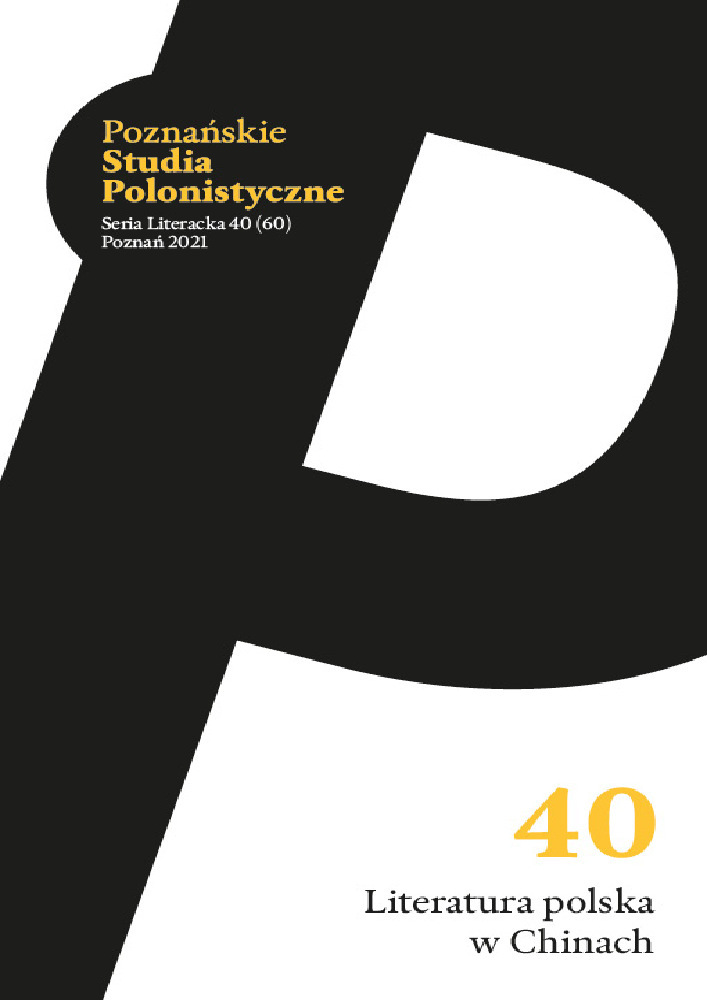Abstract
The article is an analysis of the description of the garden in Bruno Schulz’s The Cinnamon Shops (Sklepy cynamonowe) and its two translations into Chinese. Wei-Yun Lin-Górecka has translated Schulz’s prose from the original Polish, while Lu Yuan’s translation is primarily based on English versions of his work. The analysis employs methods drawn from cognitive poetics and some elements of cognitive theory of translation, especially Elżbieta Tabakowska’s ideas on imagery and translation equivalence. The study helped characterize a complex conceptual blend found in the description and trace structural changes caused by the translators’ specific decisions. The translations are characterized by a relatively high level of equivalence. The conceptual blends they comprise differ from the one created by Bruno Schulz mostly in terms of the described elements’ positions on the empathy scale, which are mainly dependent upon the translators’ manner of using the devices of animation and anthropomorphism.
References
Boase-Beier Jean (2011), A Critical Introduction to Translation Studies, Continuum, London.
Brône Geert, Vandaele Jeroen, red. (2009), Cognitive Poetics: Goals, Gains and Gaps, De Gruyter Mouton, Berlin.
Crisp Peter (2003), Conceptual Metaphor and Its Expressions, w: Cognitive Poetics in Practice, red. Joanna Gavins, Gerard Steen, Routledge, London, s. 99-113.
Danaher David S. (2006), Poetyka kognitywna a literackość: analogia metaforyczna w „Annie Kareninie”, przeł. Małgorzata Majewska, „Przestrzenie Teorii”, nr 6, s. 277-298, https://doi.org/10.14746/pt.2006.6.16.
Fauconnier Gilles, Turner Mark (2019), Jak myślimy. Mieszaniny pojęciowe i ukryta złożoność umysłu, przeł. Izabela Michalska, Fundacja Augusta hr. Cieszkowskiego, Warszawa.
Fu Xiaowei, Wang Yi (2008), The Influence of Jewish Literature in China, w: The Jewish-Chinese Nexus. A Meeting of Civilizations, red. M. Avrum Ehrlich, Routledge, Abingdon–New York, s. 118-132.
Gavins Joanna, Steen Gerard, red. (2003), Cognitive Poetics in Practice, Routledge, London.
Iversen Margaret (2006), Im blinden Feld: Hopper und das Unheimliche, w: Orte des Unheimlichen: Die Faszination verborgenen Grauens in Literatur und bildender Kunst, red. Klaus Herding, Gerlinde Gehrig, Vandenhoeck & Ruprecht, Göttingen, s. 272-299.
Jakubów Zofia (2018), Kognitywna analiza opisu zmierzchu we fragmencie „Sklepów cynamonowych” Brunona Schulza, w: Orientaliści kognitywnie, red. Joanna Jurewicz, Elipsa, Warszawa, s. 67-78.
Jurewicz Joanna (2018), Wprowadzenie, w: Orientaliści kognitywnie, red. Joanna Jurewicz, Elipsa, Warszawa, s. 7-14.
Lakoff George, Johnson Mark (1988), Metafory w naszym życiu, przeł. Tomasz Krzeszówski, PIW, Warszawa.
Lakoff George, Johnson Mark (1999), Philosophy in the Flesh: The Embodied Mind and Its Challenge to Western Thought, Basic Books, New York.
Lin-Górecka Wei-Yun (2013), Transpacyficzna transcendencja. O tłumaczeniu Schulza na język chiński, „Schulz/Forum”, nr 2, s. 113-118.
Nie Liping (2020), Lu Yuan: gen ciyu jinxing bodou yu hezuo, wei jianli meihao zhixu nuli, „Xin Jingbao”, [dostęp: 8 września 2020], https://tinyurl.com/s8pcuhy8.
Rojo Ana, Ibarretxe-Antuñano Iraide (2013), Cognitive Linguistics and Translation Studies: Past, Present and Future, w: Cognitive Linguistics and Translation: Advances in Some Theoretical Models and Applications, red. Ana Rojo, Iraide Ibarretxe-Antuñano, De Gruyter Mouton, Berlin, s. 3-30.
Schulz Bruno (1989), Opowiadania. Wybór esejów i listów, red. Jerzy Jarzębski, Ossolineum, Wrocław.
Schulz Bruno (2016), Eyu Jie: Bulunuo Shuerci xiaoshuo quanji, przeł. Lin Weiyun, [dostęp: 4 września 2020], https://yuedu.163.com/book_reader/37bcd030ad1f43d188bb9e23ed62995e_4, Guilin.
Schulz Bruno (2017), Rouguise puzi ji qita gushi, przeł. Lu Yuan, Sichuan Renmin Chubanshe, [dostęp: 4 września 2020] https://yuedu.163.com/book_reader/b12c2506de8b4c8b92b5f17bf42daa50_4, Chengdu.
Słownik języka polskiego PWN (2020), Kożuch [hasło], [dostęp: 16 września 2020], https://tinyurl.com/49dxwuva.
Stockwell Peter (2006), Poetyka kognitywna. Wprowadzenie, red. Elżbieta Tabakowska, przeł. Anna Skucińska, Universitas, Kraków.
Tabakowska Elżbieta (2001), Językoznawstwo kognitywne a poetyka przekładu, przeł. Agnieszka Pokojska, Universitas, Kraków.
Wojda Dorota (2009), Bruno Schulz and the Magical Realism of Gabriel García Márquez in „One Hundred Years of Solitude”, w: (Un)masking Bruno Schulz: New Combinations, Further Fragmentations, Ultimate Reintegrations, red. Dieter De Bruyn, Kris Van Heuckelom, Rodopi, Amsterdam–New York, s. 173-193.
Wu Lan (2010), Bruno Schulz w Chinach, „Postscriptum Polonistyczne”, nr 2 (6), s. 253-260.
Yang Deyou (2011), Shuerci zuopin yishi, „Mingzuo Xinshang”, nr 6, s. 5-17.
License
Authors
Authors of texts accepted for publication in „Poznańskie Studia Polonistyczne. Seria Literacka” are required to complete, sign and return to the editor's office the Agreement for granting a royalty-free license to works with a commitment to grant a CC sub-license.
Under the agreement, the authors of texts published in „Poznańskie Studia Polonistyczne. Seria Literacka” grant the Adam Mickiewicz University in Poznań a non-exclusive, royalty-free license and authorize the use of Attribution-NoDerivatives 4.0 International (CC BY-ND 4.0)Creative Commons sub-license.
The authors retain the right to continue the free disposal of the work.
Users
Interested Internet users are entitled to use works published in „Poznańskie Studia Polonistyczne. Seria Literacka” since 2016, for non-commercial purposes only, under the following conditions:
- attribution - obligation to provide, together with the distributed work, information about the authorship, title, source (link to the original work, DOI) and the license itself.
- no derivatives - the work must be preserved in its original form, without the author's consent it is not possible to distribute the modified work, such as translations, publications, etc.
Copyrights are reserved for all texts published before 2016.
Miscellaneous
Adam Mickiewicz University in Poznań retains the right to magazines as a whole (layout, graphic form, title, cover design, logo etc.).
